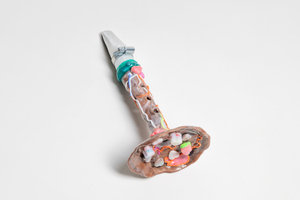air 11-13, Biomüllbeutel
Parent sets (1)Show all relations
The selected media entry was added to these sets.
1 Items
- Page 1 of 1
Work Detail
- Title
- Work Detail
- Title (en)
- Work Detail
- Author
- Description (de)
- Plastic Fugue als Diplomprojekt besteht aus vier Teilen:
0. Introducing ipcl, ein Einführungsvideo, das eine Produktpräsentation imitiert. CEO Framey von „Moberm“, einer fiktiven Firma, spricht darüber, wie Moberm aufgrund der Kindheitserinnerungen des CEOs beschloss, sein Geschäft auf Musikinstrumente auszuweiten. Das Video behauptet selbstbewusst die Multifunktionalität der air&dust-Instrumente, bleibt dabei jedoch letztlich inhaltsleer. Framey, die sprechende Figur, artikuliert indirekt die Erzählung der Person hinter dem Werk und stellt gleichzeitig eine von Stereotypen und Neoliberalismus durchzogene Kunststruktur nach.
1. Plastic Fugue, eine interaktive Klanginstallation, bestehend aus sechs Flöten (air 5-10, air Pp 1), die jeweils nur einen Ton erzeugen und über codierte Dirigierknöpfe ferngesteuert aktiviert werden. Die Reihenfolge der Töne ist jedes Mal zufällig. Die Fuge wird auf ihre Struktur reduziert und in ein Spiel mit Sequenz und Zeit überführt. Anstelle der idealisierten Ordnung stelle ich mir eine offenere Art der Klangmontage vor, eine Art demokratischer Kontrapunkt.
2. Sax Recital, ein Video, gespielt von Arno Arial mit der DIY-Saxophone-Serie, deren Mundstücke auf Open-Source-3D-Modellen basieren und handgefertigt aus PCL und PLA bestehen. Das Stück wurde aufgenommen, während Arial Kopfhörer trug, um klassische Musik zu hören, sowie lärmunterdrückende Ausrüstung darüber, um sowohl äußere als auch selbst erzeugte Klänge auszublenden. Das Video läuft im Ausstellungsraum in Dauerschleife und bildet gemeinsam mit Plastic Fugue eine gebrochene fugenhafte Gegenstimme.
3. Pp 1-8, air 1-4 und dust 1-2, frühe Instrumente und Polymer-Gemälde, bei denen ich keinen überzeugenden Grund fand, weiterhin traditionelle Materialien zu verwenden. Also entschied ich mich, sie stattdessen mit PCL und PLA zu schaffen.
Die oben genannten Arbeiten sind das Ergebnis eines Instrumentenbaus durch DIY-Praxis und Open-Source-Dateien aus dem Internet, indem die Illusion der klassistischen Form geschmolzen, vermischt und in biologisch abbaubare Polymere gegossen wurde, nicht nur mit der Hand, sondern auch mit dem 3D-Drucker. Eine besondere Qualifikation ist für die Herstellung nicht nötig. Die Bauanleitungen für diese DIY-Instrumente werden während der Ausstellung und auf der Website zur Verfügung gestellt.
Wenn das Publikum die Knöpfe drückt, spielt dieses neutrale Orchester eine fugenhafte Struktur, bei der sich alle paar Sekunden Klänge überlagern. Die Kontrolle über das Orchester liegt beim Publikum. Die Arbeit hinterfragt geerbte Hierarchien, sowohl durch Material als auch durch Methode.
Für Kinder, die früh gelernt haben, nichts zu verlangen, und für Erwachsene, die mit dieser Erinnerung aufgewachsen sind.
- Plastic Fugue als Diplomprojekt besteht aus vier Teilen:
- Description (en)
- Plastic Fugue as Diplom project features four parts.
0. Introducing air&dust, a (introduction) video that appropriates a product unveiling conference. CEO Framey from Moberm, a pseudo corporation, speaks about how Moberm decided to expand its business into musical instruments based on the CEO's childhood memory. It boldly claims air&dust’s multifunctionality in musical instruments but remains ultimately hollow.
Framey, the speaking character, serves as a device that indirectly voices the artist's narrative within the work, while also reenacting the structure of art polluted by stereotypes and neoliberalism. The character is made with the virtual youtuber avatar technique.
1. Plastic Fugue, an interactive sound installation which consists of six flutes (air 5-10, air Pp 1) with air pumps, each producing a single tone and activated remotely through coded conducting buttons. The order of play is random every time as the buttons signal remotely.
The fugue has long stood as a symbol of musical authority and elitism, a form that represents technical mastery and the traditional hierarchy of composition. In my work, I try to break apart that formal authority, stripping the fugue down to its bare structure and shifting it toward an exploration of sequence and time. Instead of upholding its idealized order, I imagine a more open, accessible way of assembling sound, a kind of democratic counterpoint. You could call it a process of unmaking the fugue, of abstracting it.
2. Sax Recital, a recital video piece played by Arno Arial featuring DIY-Saxophone series, which is a quite decent structure of mouthpiece built using open-source 3D models and handcrafted with PCL and PLA. Filmed while Arial was wearing earphones for listening to classical music and soundproof gear on top to block out both external and self-produced instrumental sound. This piece is loop-playing all the time in the exhibition, making broken fugal counterpoint together with Plastic Fugue.
3. Pp 1-9, air 1-4, and dust 1-2, early-made instruments and polymer paintings which I found no compelling reason to continue using traditional materials, and so I ended up creating them with PCL and PLA.
The above instruments and paintings are the result of instrument-making through DIY-ness and open-source files from the internet by melting, merging, and mixing the illusion of classism's shape into biodegradable polymers, not only with a hand, but also with a 3D printer. However, any sacred qualification to make is not needed. DIY instructions for these DIY instruments are distributed at the exhibition and website.
When audiences press the buttons, this neutral orchestra plays a Fugue-like style, which overlaps sounds every few seconds. Placing control of the orchestra in the hands of the audience, the work democratizes a position of authority and questions inherited hierarchies through both material and method.
- Plastic Fugue as Diplom project features four parts.
- Contributors
- Title
- Work Detail
- Projektleiter/in
- Semester
- Program of Study
- Type of graduation project
- Imported on
- 12.07.2025
- Parent sets
- 1
- Set is related to
- 0 36
